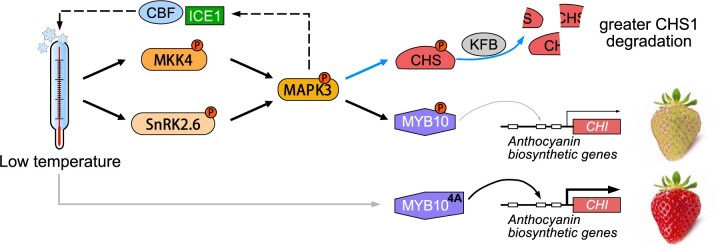Figure 9.
MAPK3 is an important regulator of low-temperature response and ripening-related anthocyanin accumulation in strawberry fruits. When strawberry fruits are exposed to low-temperature stress, fruits perceive the low temperature possibly through the MAPK3-ICE1-CBFs signaling pathway, whereby MAPK3 is activated by SnRK2.6- and MKK4-mediated phosphorylation. The MKK4–MAPK3 module then catalyzes the phosphorylation of the rate-limiting enzyme CHS1 and upregulates the expression of the ubiquitination-related gene KFB1 to accelerate CHS1 degradation. At the same time, both the MKK4–MAPK3 and SnRK2.6–MAPK3 modules allow the phosphorylation of the transcription factor MYB10, the central activator of anthocyanin biosynthesis, leading to a reduction in its transcriptional activity. MAPK3, therefore, inhibits ripening-related anthocyanin accumulation by downregulating the transcriptional activity of MYB10 and decreasing CHS1 protein levels in strawberry fruits. Additionally, compared to MYB10, its phosphorylation-dead mutant MYB104A shows a reduced level of MAPK3-mediated phosphorylation, has higher transcriptional activity upon CHI and is not sensitive to low temperatures; hence, MYB104A may protect strawberry fruits from delayed coloration due to low temperatures. Dark arrows indicate activation, and thin gray arrow shows repression. Blue arrows indicate the pathways only mediated by the “FvMKK4-FvMAPK3” module, while the dark arrows represent the pathways regulated by both the “FvSnRK2.6-FvMAPK3” and “FvMKK4-FvMAPK3” modules. Dashed lines indicate the low-temperature sensing pathway. Thick gray arrow indicates that the low-temperature response is blocked.

